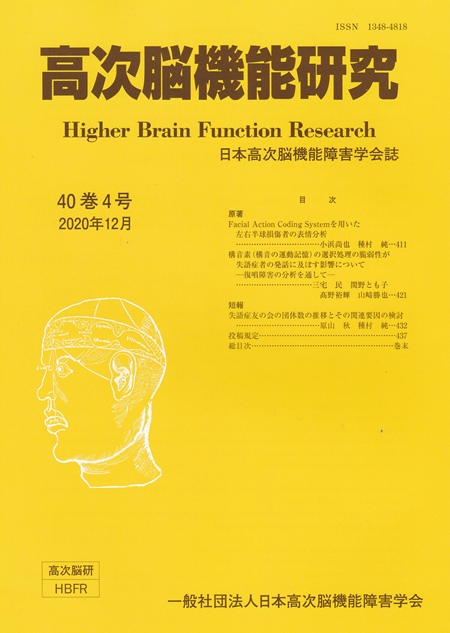
- Issue 4 Pages 411-
- Issue 3 Pages 239-
- Issue 2 Pages 131-
- Issue 1 Pages 1-
- |<
- <
- 1
- >
- >|
-
Naoya Obama, Jun Tanemura2020 Volume 40 Issue 4 Pages 411-420
Published: December 31, 2020
Released on J-STAGE: January 04, 2022
JOURNAL FREE ACCESS
We examined the facial expression characteristic in patients with damaged left and right hemispheres. A total of 10 participants with left hemispheric damaged (LHD) , 10 with right hemispheric damaged stimulus with low emotional arousal effect, whereas a conversation with an emotional topic was used as stimulus with high effect. The International Affective Picture Systems were used for emotional still images, and participants selected their impression for the stimulus from three choices: like, dislike, and neither. Facial expressions were evaluated using the Facial Action Coding System (FACS) , which were objective evaluation system based on facial anatomy. Facial expressions were recorded with a video camera. No significant difference was found in the selected impression among the three groups under the still image condition. The total number of facial expressions in the RHD group under still image condition was smaller than that in the LHD and adults without hemispheric damage groups. Moreover, no significant difference was observed in conversation conditions among the three groups. The emotional facial expressions in the RHD group were considered to be affected by the emotional effect of stimulation. We believe that this is the first study that used FACS to elucidate the facial expression characteristic in patients with LHD and RHD.View full abstractDownload PDF (462K) -
Tami Miyake, Tomoko Sekino, Hiroaki Takano, Katsuya Yamazaki2020 Volume 40 Issue 4 Pages 421-431
Published: December 31, 2020
Released on J-STAGE: January 04, 2022
JOURNAL FREE ACCESS
In this study, we reported a patient with aphasia whose output is more severely impaired than input, and whose spontaneous speech was almost limited to non-meaningful recurrent utterances. The patient also had serious difficulty in word repetition, though abilities in phonemic discrimination and phonological manipulation were spared, and there was no evidence of typical anarthria or any dysarthrias. We examined the patientʼs competence in repeating monosyllables, the units smaller than a word, consecutively in random order. The results showed that performance was much worse with the added burden of rapidity. Based on these results, we provided the patient training in repeating monosyllables with “rapidity, repetitiveness, and accuracy,” after which repetition performance of words improved significantly. We hypothesized that the impairment of competence in repeating monosyllables consecutively with the additional burden of rapidity was caused by vulnerability of selection of memory of articulatory movements in the motor realization process. Because this process to select the memory of articulatory movements is one step in the last phase of utterance, we estimated that its disturbance would wield an influence on utterance modalities other than repetition. Further case studies will be needed in order to decide if we should identify the disturbance as anarthria.View full abstractDownload PDF (839K)
-
Shu Harayama, Jun Tanemura2020 Volume 40 Issue 4 Pages 432-436
Published: December 31, 2020
Released on J-STAGE: January 04, 2022
JOURNAL FREE ACCESS
【Purpose】Aphasia peer circles started their activities in the 1980s throughout Japan, but they have been decreasing in number since the early 2000s. The purpose of this study was to identify the reasons for increases or decreases in the number of aphasia peer circles.【Subjects】The subjects were three appointees who have served as directors of the national association of aphasia.【Method】The following questions were asked: (1) the significance of aphasia peer circles, (2) the background to establishing the national organization, (3) reasons for increases in the number of affiliated organizations, (4) reasons for their decrease, (5) reasons why decreases have continued, and (6) what is needed for future aphasia peer circles. Interview contents were converted into text data and weighted text analysis was performed.【Result】The significance of the aphasia peer circle was described to be “making friendships.” Factors increasing the number of aphasia peer circles were “active recruiting of aphasics and their families” and “cooperation of speech therapists (STs) .” Factors decreasing the number of aphasia peer circles were “spread of the Long-Term Care Insurance System,” “aging of active members” and “successor difficulties”. What is needed for future aphasia peer circles was said to be “participation of STs” and “appeals to the government.”【Conclusion】Changes in the number of aphasia peer circles were associated with the presence of people who worked with dedication and the aging of such people, paucity of successors, and spreading impact of the Long-Term Care Insurance System.View full abstractDownload PDF (372K)
- |<
- <
- 1
- >
- >|